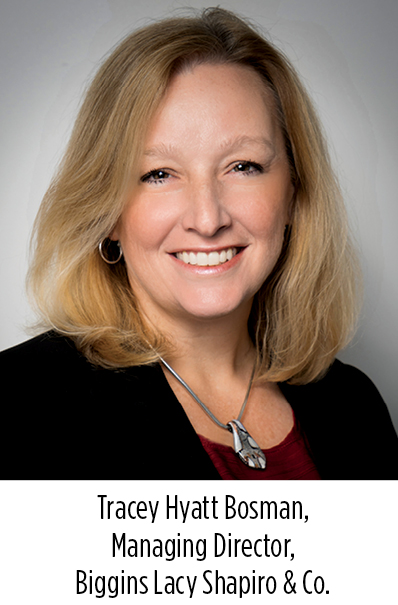What does quality of life mean in 2023? Is the definition the same as it was 10 years ago? How important is it to companies exploring location options? According to several top site consultants contacted for this article, it means much the same as it always has in some respects. But some important parts of the landscape have shifted too. On this they agree: Attracting talent is — or should be — as or more important to locations than attracting companies.
“Historically, quality of life meant the quality of life for the executive team,” says Tracey Hyatt Bosman, managing director at Biggins Lacy Shapiro & Co. “It was about golf courses, executive housing and top-ranking school districts. Today, quality of life is about the community’s offering for the larger work population. This started when companies began focusing on the Millennial generation but has continued and broadened to be about attracting and retaining talent. Today it is about outdoor recreation opportunities, a sense of place — particularly in the downtown area — a reasonable cost of living, vibrancy, walkability and ‘cool factor.’ Clients are also looking to check the basic boxes, such as positive population growth, low crime rates and safe neighborhoods, a good education system (private and public), and (at least in urban areas) a good public transportation network.”
 Didi Caldwell, president and founding principal, Global Location Strategies: “Quality of life for our projects, which are industrial in nature, has always been part of the consideration but lower down on the weighting scale. You have to talk through all of the technical requirements, and then you look at quality of life and whether it gives one location an edge over another that is equal in all other ways. It’s more of a tiebreaker. For the kinds of projects we work on, that is still the case. But workforce has become much more important and has a heavier weight.
Didi Caldwell, president and founding principal, Global Location Strategies: “Quality of life for our projects, which are industrial in nature, has always been part of the consideration but lower down on the weighting scale. You have to talk through all of the technical requirements, and then you look at quality of life and whether it gives one location an edge over another that is equal in all other ways. It’s more of a tiebreaker. For the kinds of projects we work on, that is still the case. But workforce has become much more important and has a heavier weight.
“Today,” adds Caldwell, “people are moving to places to live with the assumption that they will be able to find a job. Economic developers need to have more than one focus. I’m not saying they should forget about recruiting the company, but they need to spend at least as much time thinking about how to attract talent. When we are looking at communities, we want to know what the economic developers or communities are doing to improve their quality of life and proactively recruit people to their location.”
 Quality of Place
Quality of Place
Two consultants put a different spin on the topic. One is Jay Garner, president of Garner Economics, LLC.
“I don’t call it quality of life, but rather quality of place,” says Garner. “Quality of life is subjective. Quality of place can be measured. For example, climate is subjective. Some people like the heat; others like the cold. It’s a subjective variable. But with quality of place, you can measure all the key variables that companies consider important in their overall decision-making process: public safety, quality of K-12 education, healthcare, higher education options, housing availability and affordability, central business districts and recreational opportunities. It’s all about talent attraction and retention.”
 To a large extent, locations understand this, says Garner.
To a large extent, locations understand this, says Garner.
“Many communities are doing a much better job of this than, say, 10 to 15 years ago,” he relates. “Main Street programs have helped engage communities to step up. Same with litter remediation programs, such as local Keep America Beautiful initiatives. Many smaller and rural communities are doing a better job than the larger, more urban communities, especially when it comes to public safety, recreational options and their downtown central business districts. I always tell community leaders that their downtown is the living room of their community. They should have Main Streets that are emblematic of the ethos and culture of their communities, such as Fairhope, Alabama, and Covington and Franklin, Tennessee. I have seen downtowns with more than an 80% storefront vacancy rate and I have also seen downtowns with close to a 100% occupancy rate. The latter shows much better than the former.”
 Dennis Donovan, principal at Wadley Donovan Gutshaw Consulting, concurs.
Dennis Donovan, principal at Wadley Donovan Gutshaw Consulting, concurs.
“Most economic development organizations realize that quality of place (or quality of life) is integral to business attraction and retention,” he says. “For instance, improving public education has positive workforce implications both for existing companies and firms seeking to locate new operations. In recent years, we have seen more economic development groups create partnerships to improve quality of place. Examples include the Indy Partnership, Greater Louisville Inc., Huntsville/Madison County (Alabama) Chamber, Greater Wichita Partnership and Lubbock Economic Development Alliance. Also, when we ask economic developers to provide data and insights on quality-of-life considerations, they typically display full capabilities.”
The consultants agree that quality of life is more important today than in the past.
“It’s definitely more important and for a broader cross-section of projects because the competition for labor is so intense,” says Tracey Hyatt Bosman. “Companies want to take every opportunity to position themselves to be able to attract and retain talent. In the past, quality of life was a topic reserved primarily for headquarters and R&D searches. In 2023 it doesn’t matter if it’s food production, auto parts manufacturing, renewable energy generation or biologics. Virtually everyone is thinking about the quality of life of the proposed locations.”
Dennis Donovan: “It is of far greater importance for companies relocating operations or heavily dependent on national recruiting. In either case, quality of life will be influential in the number of current or prospective employees accepting relocation offers. Sometimes population and workforce diversity, quality jobs for trailing spouses or partners, green or sustainable policies, an absence of regressive social policies and area perception can also comprise key criteria.”
These are increasingly important criteria in today’s business world as companies seek to implement economic, social and corporate governance (ESG) and environmental policies. Factors like minority population, diversity, income disparity and housing are becoming more common considerations as workers weigh their employment options.
“It seems there is more for companies to react to now — things like civil liberties and what stand they take on issues like reproductive rights and education,” says Didi Caldwell. “Some companies have a very strong opinion about that, especially if they’re very customer facing. By and large it’s about attracting the workers but there is this extra layer that you must look at. It’s these new criteria around governance and social responsibility.”

